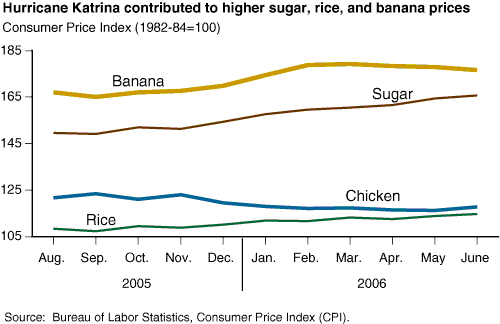Despite Katrina, Overall Food Prices Stable
- by Ephraim Leibtag
- 9/1/2006
One year ago, Hurricane Katrina slammed into New Orleans and the surrounding Gulf Coast areas. The resulting loss of electricity, lack of fuel, and damage to roads and port facilities temporarily interrupted the movement and processing of agricultural products and raised questions about whether consumers in that region would face steep increases in food prices. But, despite some production cost increases and supply disruptions, overall food prices in the region most affected by Katrina rose at rates similar to those in other regions. Since August 2005, retail food prices are up 1.9 percent in the U.S., with the Northeast region experiencing the largest increase, 2.9 percent. Interestingly, the South, where damage from the storm was the greatest, experienced a 1.8-percent increase in food prices, only slightly higher than the 1.4- and 1.7-percent price increases in the West and Midwest, respectively.
While overall prices have been stable over the past year, certain products were more vulnerable to Katrina’s destruction. Since 85 percent of U.S. sugarcane production, 17 percent of broiler production, and 14 percent of rice production occurs in the portions of Alabama, Florida, Louisiana, and Mississippi most affected by Katrina, these products were expected to be impacted the most. In addition, since the majority of U.S. banana imports typically come into the Port of New Orleans from Central and South America, a storm-induced supply disruption might be expected to increase retail banana prices.
Nationally, retail sugar prices have, in fact, had one of the largest price increases—up 10.8 percent—between August 2005 and September 2006, while banana and rice prices were up 5.7 and 5.9 percent, respectively, over the period. Chicken prices, however, bucked the trend, dropping 3.4 percent. This is not surprising, as other factors impacted the market for chicken, including depressed global demand for some poultry products due to avian influenza outbreaks in Europe and Asia. This illustrates that other factors also influence retail food prices and may have contributed to the observed price changes.
The potential for longer lasting and more widely felt price increases from Katrina comes from increases in energy costs. Katrina destroyed oil platforms in the Gulf and disrupted oil delivery and refining, causing the prices of gasoline and other petroleum products to increase sharply.
Higher prices for gasoline and diesel fuel increase farm production costs, but with farm value accounting for about one-fifth of retail food prices, higher farm prices pass through to retail at only a fraction of their increase. Higher energy prices also increase the cost of processing, manufacturing, and transporting foods. However, direct energy and transportation costs account for only 7.5 percent of the overall average retail food dollar.
This article is drawn from:
- Consumer and Producer Price Indexes. (n.d.). U.S. Department of Agriculture, Economic Research Service.
You may also like:
- Food Prices, Expenditures, and Establishments. (n.d.). U.S. Department of Agriculture, Economic Research Service.



